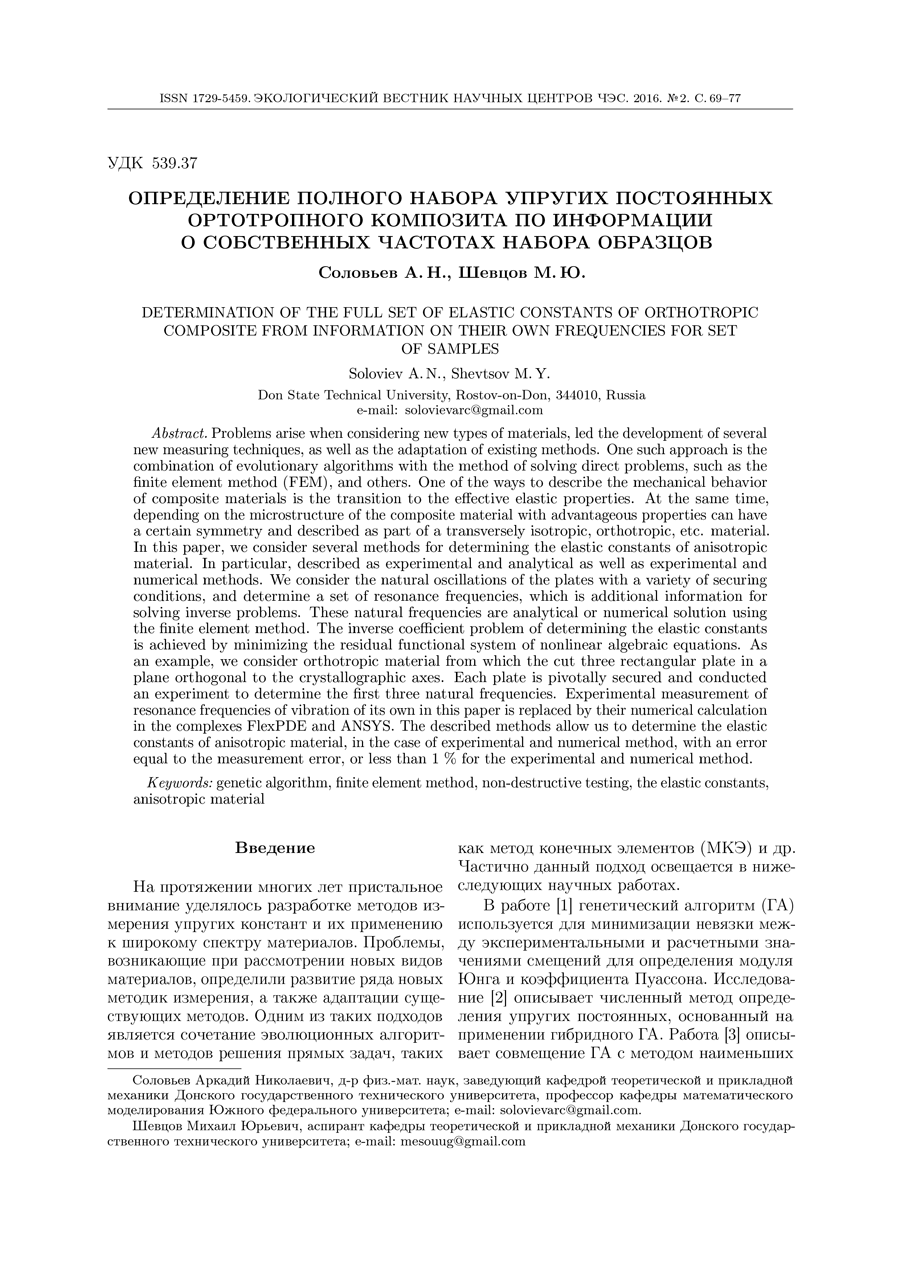Determination of the full set of elastic constants of orthotropic composite from information on their own frequencies for set of samples
UDC
539.37Abstract
Problems arise when considering new types of materials, led the development of several new measuring techniques, as well as the adaptation of existing methods. One such approach is the combination of evolutionary algorithms with the method of solving direct problems, such as the finite element method (FEM), and others. One of the ways to describe the mechanical behavior of composite materials is the transition to the effective elastic properties. At the same time, depending on the microstructure of the composite material with advantageous properties can have a certain symmetry and described as part of a transversely isotropic, orthotropic, etc. material. In this paper, we consider several methods for determining the elastic constants of anisotropic material. In particular, described as experimental and analytical as well as experimental and numerical methods. We consider the natural oscillations of the plates with a variety of securing conditions, and determine a set of resonance frequencies, which is additional information for solving inverse problems. These natural frequencies are analytical or numerical solution using the finite element method. The inverse coefficient problem of determining the elastic constants is achieved by minimizing the residual functional system of nonlinear algebraic equations. As an example, we consider orthotropic material from which the cut three rectangular plate in a plane orthogonal to the crystallographic axes. Each plate is pivotally secured and conducted an experiment to determine the first three natural frequencies. Experimental measurement of resonance frequencies of vibration of its own in this paper is replaced by their numerical calculation in the complexes FlexPDE and ANSYS. The described methods allow us to determine the elastic constants of anisotropic material, in the case of experimental and numerical method, with an error equal to the measurement error, or less than 1% for the experimental and numerical method.
Keywords:
genetic algorithm, finite element method, non-destructive testing, the elastic constants, anisotropic materialReferences
- Baranov I.V., Vatul'yan A.O., Solov'yev A.N. Ob odnom geneticheskom algoritme i yego primenenii v obratnykh zadachakh identifikatsii uprugikh sred [A genetic algorithm for solving the inverse identification problem for elastic media]. Vychislitel'nyye tekhnologii [Computational technologies], 2006, vol. 11, no. 3, pp. 14-26. (In Russian)
- Hwang S.-F., Wu J.-C., He R.-S. Identification of effective elastic constants of composite plates based on a hybrid genetic algorithm. Composite Structures, 2009, vol. 90, pp. 217-224.
- Liu G.R., Han X., Lam K.Y. A combined genetic algorithm and nonlinear least squares method for material characterization using elastic waves. Comput. Methods Appl. Mech. Engrg., 2002, vol. 191, pp. 1909-1921.
- Harb N., Labed N., Domaszewski M., Peyraut F. A new parameter identification method of soft biological tissue combining genetic algorithm with analytical optimization. Comput. Methods Appl. Mech. Engrg., 2011, vol. 200, pp. 208-215.
- Muc A., Gurba W. Genetic algorithms and finite element analysis in optimization of composite structures. Composite Structures, 2001, vol. 54, pp. 275-281.
- Comellas Ester, Valdez S.I., Oller S., Botello S. Optimization method for the determination of material parameters in damaged composite structures. Composite Structures, 2015, vol. 122, pp. 417-424.
- Liu G.R., Han X. Determination of material property of functionally graded cylinder using genetic algorithm. Inverse problems in engineering mechanics III, 2002, pp. 117-124.
- Hidalgo J.I., Fernandez R., Colmenar J.M., Cioffi F., Risco-Martin J.L., Gonzalez-Doncel G. Using evolutionary algorithms to determine the residual stress profile across welds of age-hardenable aluminum alloys. Applied Soft Computing, 2016, vol. 40, pp. 429-438.
- Balasubramaniam K., Rao N.S. Inversion of composite material elastic constants from ultrasonic bulk wave phase velocity data using genetic algorithms. Composites Part B: Engineering, 1998, vol. 29, no. 2, pp. 171-180.
- Every A.G. Determination of the elastic constants of anisotropic solids. NDT & E International, 1994, vol. 27, no. 1, pp. 3-10.
- Gsell D., Dual J. Non-destructive evaluation of elastic material properties in anisotropic circular cylindrical structures. Ultrasonics, 2004, vol. 43, pp. 123-132.
- Zhang H., Lin X., Wang Y., Zhang Q., Kang Y. Identification of elastic-plastic mechanical properties for bimetallic sheets by hybrid-inverse approach. Acta Mechanica Solida Sinica, 2010, vol. 23, no. 1, pp. 29-35.
- Eremin A.A., Glushkov E.V., Glushkova N.V., Lammering R. Evaluation of effective elastic properties of layered composite fiber-reinforced plastic plates by piezoelectrically induced guided wavesand laser Doppler vibrometry. Composite Structures, 2015, vol. 125, pp. 449-458.
- Zhao J., Qiu J., Ji H. Reconstruction of the nine stiffness coefficients of composites using a laser generation based imaging method. Composites Science and Technology, 2016, vol. 126, pp. 27-34.
- Akopyan V.A., Bykov A.A., Rozhkov Ye.V., Solov'yev A.N., Shevtsov S.N. K opredeleniyu effektivnykh svoystv polimerkompozitnogo materiala na osnove garmonicheskogo i modal'nogo analiza [Determination of the effective properties polimerkompozitnogo material based on harmonic and modal analysis]. Mekhanika kompozitsionnykh materialov i konstruktsiy [Mechanics of Composite Materials and Structures], 2008, vol. 14, no. 1, pp. 35-48. (In Russian)
- Pobedrya B.Ye. Mekhanika kompozitsionnykh materialov [Mechanics of Composite Materials]. Moscow, MGU Publ. 1984, 336 p. (In Russian)
- Novatskiy V. Teoriya uprugosti [Theory of Elasticity]. Moscow, Mir Publ. 1975, 256 p. (In Russian)
- Korshunov S.V. Osnovy stroitel'noy mekhaniki mashin [Fundamentals of structural mechanics machines]. Moscow, Mashinostroyeniye, 1973, 456 p. (In Russian)
- AI::Genetic::Pro - Efficient genetic algorithms for professional purpose. Available at: URL: http://search.cpan.org/\textasciitilde strzelec/AI-Genetic-Pro-0.4/lib/AI/Genetic/Pro.pm. (accessed 20.04.2016).
- The Perl Programming Language. Available at: http://www.perl.org/ (accessed 20.04.2016).
Downloads
Issue
Pages
Submitted
Published
How to Cite
Copyright (c) 2016 Soloviev A.N., Shevtsov M.Yu.

This work is licensed under a Creative Commons Attribution 4.0 International License.




